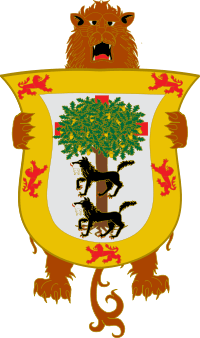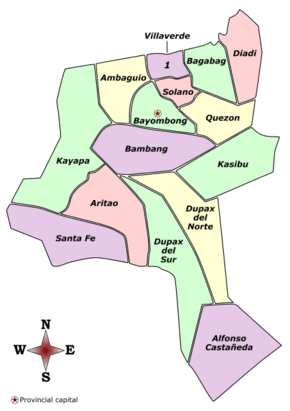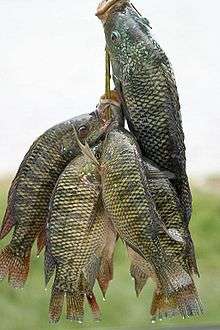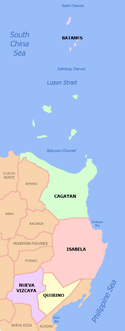Nueva Vizcaya
| Nueva Vizcaya | |||
|---|---|---|---|
| Province | |||
| Province of Nueva Vizcaya | |||
|
Nueva Vizcaya Provincial Capitol | |||
| |||
 Location in the Philippines | |||
| Coordinates: 16°29′N 121°09′E / 16.48°N 121.15°ECoordinates: 16°29′N 121°09′E / 16.48°N 121.15°E | |||
| Country | Philippines | ||
| Region | Cagayan Valley (Region II) | ||
| Founded | 1839 | ||
| Capital | Bayombong | ||
| Government | |||
| • Type | Sangguniang Panlalawigan | ||
| • Governor | Carlos M. Padilla (NP) | ||
| • Vice Governor | Lambert Galima (NP) | ||
| Area[1] | |||
| • Total | 3,975.67 km2 (1,535.01 sq mi) | ||
| Area rank | 31st out of 81 | ||
| Population (2015 census)[2] | |||
| • Total | 452,287 | ||
| • Rank | 60th out of 81 | ||
| • Density | 110/km2 (290/sq mi) | ||
| • Density rank | 68th out of 81 | ||
| Demonym(s) | Novo Vizcayano | ||
| Divisions | |||
| • Independent cities | 0 | ||
| • Component cities | 0 | ||
| • Municipalities |
15
| ||
| • Barangays | 275 | ||
| • Districts | Lone district of Nueva Vizcaya | ||
| Time zone | PHT (UTC+8) | ||
| ZIP code | 3700–3714 | ||
| IDD : area code | +63 (0)78 | ||
| ISO 3166 code | PH-NUV | ||
| Spoken languages | |||
| Website |
www | ||
Nueva Vizcaya (English: New Biscay) is a province of the Philippines located in Cagayan Valley region in Luzon. Its capital is Bayombong. It is bordered by Benguet to the west, Ifugao to the north, Isabela to the northeast, Quirino to the east, Aurora to the southeast, Nueva Ecija to the south, and Pangasinan to the southwest.
Etymology

The name Nueva Vizcaya is been derived from the name of the province of Biscay (called Vizcaya in Spanish, Bizkaia in Basque) in the Spanish rule period. This can be seen in the right part of the seal, a representation of the heraldic of Vizcaya in Spain.
History
Spanish period
The areas of present-day Nueva Vizcaya used to be a territory of the vast Provincia de Cagayan,[3] which was once an integral political unit with one governor. Organized religion in Nueva Vizcaya dates back to the year 1607, when the Dominican Order arrived at the hinterlands of the province to preach their beliefs. It was not until 1609, however, that the first settlement of a religious order was established in the southern half of the province. In 1702, a convent was erected in Burubur at the foot of the Caraballo Mountains in Santa Clara, which is now a barangay in the town of Aritao. It was on this site that the first mass in Nueva Vizcaya was celebrated and the first baptism of a Christian convert was held. In 1839, upon the advice of the alcalde mayor of Cagayan,[4] then-Governor Luis Lardizabal issued an order creating the politico-military province of Nueva Vizcaya.[3] The order was approved by a Royal Decree on April 10, 1841. The original province covered the areas of present-day Nueva Vizcaya, Quirino, Mountain Province, and a large portion of Isabela, as well as much of Aurora.[3] Civil government was established in the province by the Philippine Commission in 1902.[4]
The territories of Nueva Vizcaya were greatly reduced as a result of the formal creation of the province of Isabela in May 1865, wherein a large portion of its northern territory was ceded to the newly-born province.[3][4]
American period
In 1908, the northwestern territory of Nueva Vizcaya was annexed to the newly organized sub-province of Ifugao.[3] The survey executed by the Bureau of Lands in 1914 further caused the diminution of its area and reduced again upon the enactment of the Administrative Code of 1917.[4]
World War II
During the Second World War, Balete Pass was the scene of a major battle between the Japanese and American forces, with the Americans gaining the victory on 31 May 1945.[3][5]:510,535
Post-war era
In 1971, with the passage of Republic Act No. 6394, Quirino, which was then a sub-province of Nueva Vizcaya, was separated from its mother province and made into a regular province.[3][4][6][7]
Since Nueva Vizcaya's birth as a province, traces of the culture and customs of its early settlers—the Ilongots (Bugkalot), Igorots, Ifugaos, Isinais, and the Gaddangs—can still be seen.[8] The influx of civilization and the infusion of modern technology to the life stream of the province induced immigration from adjacent provinces.
Geography
Surrounded by North Luzon's three large mountain ranges, Nueva Vizcaya is generally mountainous, varying from steep mountains to rolling hills, with some valleys and plains.[4] It is bordered on the west by the Cordillera mountains, on the east by the Sierra Madre mountains, and on the south by the Caraballo Mountains.[3] The province (and the entire Cagayan Valley) are separated from the Central Luzon plains by the Caraballo Mountains.
The province has a total land area of 3,975.67 square kilometres (1,535.01 sq mi).[9] The southernmost province in the Cagayan Valley region, Nueva Vizcaya lies approximately 268 kilometres (167 mi) north of Metro Manila and can be reached by land via the Cagayan Valley Road (Maharlika Highway).
Administrative divisions
Nueva Vizcaya comprises 15 municipalities, with Bayombong as the provincial capital and major educational center, Bambang (the agricultural hub) and Solano (the financial district) as the major commercial centers, and Kayapa as the summer capital and "vegetable bowl" of the province. All municipalities are encompassed by a lone legislative district.[9]
|
 | |||||||||||||||||||||||||||||||||||||||||||||||||||||||||||||||||||||||||||||||||||||||||||||||||||||||||||||||||||||||||||||||||||||||||||||||||||||||||||||||||||||||||||||||||||||||||||||||||||||||||||||||||||||||||||||||||||||||||||||||||
Barangays
The 15 municipalities of the province comprise a total of 275 barangays, with Roxas in Solano as the most populous in 2010, and Santa Rosa in Santa Fe as the least.[10]
Government
Nueva Vizcaya has one congressional district, although there has been a longtime proposal to divide the province into two congressional districts: "North District," comprising the northern municipalities; and "South District," composed of the southern towns.
Demographics

| Population census of Nueva Vizcaya | ||
|---|---|---|
| Year | Pop. | ±% p.a. |
| 1990 | 301,179 | — |
| 1995 | 334,965 | +2.01% |
| 2000 | 366,962 | +1.98% |
| 2007 | 397,837 | +1.12% |
| 2010 | 421,355 | +2.11% |
| 2015 | 452,287 | +1.36% |
| Source: Philippine Statistics Authority[2][10][10] | ||
The population of Nueva Vizcaya in the 2015 census was 452,287 people,[2] with a density of 110 inhabitants per square kilometre or 280 inhabitants per square mile.
Nueva Vizcaya is home to about 18 indigenous peoples, which includes the major tribes of the Ifugao (Quezon, Bagabag, Kasibu), Gaddang (Solano and Bayombong), Isinai (Dupax del Sur and Bambang), Dumagat (Aritao), Kalanguya (Santa Fe),; and the Bugkalot (Alfonso Castañeda and Dupax del Norte).[8]
Every last week of May, these ethnolinguistic groups gather to celebrate the Ammungan festival (formerly Panagyaman festival), a week-long affair culminating on May 24, the province's foundation day.[8]
Religion
Large percentage of Roman Catholic by about 70% reflects the province's strong Catholic influence in cultural and political aspects. Other faiths are divided among Aglipayan Church which has a large minority about 20%, Baptist, Iglesia Ni Cristo, The Church of Jesus Christ of Latter-day Saints, Jehovah's Witnesses, Seventh-day Adventist and other Evangelical Christians as well as Muslims.
Economy

Agriculture is the main industry in the province, together with rice, corn, fruits and vegetables as major crops.[3] Nueva Vizcaya is a major producer of citrus crops in the country, principally pomelo, ponkan and oranges. The Nueva Vizcaya Agricultural Terminal in Bambang supplies the demand of neighboring provinces and Metro Manila. There is a mining industry in the province which added to the provincial income.[11][12]
According to the Mines and Geosciences Bureau, deposits of metallic minerals discovered in the province are copper, gold, molybdenum and pyrite. Non-metallic deposits include red clay, white clay and limestone, with sand and gravel being the most abundant deposits in the province.[13]
On January 11, 2008, the Cagayan Bureau of Fisheries and Aquatic Resources (BFAR) stated that tilapia (species of cichlid fishes from the tilapiine cichlid tribe) production grew and Cagayan Valley is now the Philippines’ tilapia capital (Saint Peter's fish). Production supply grew 37.25% since 2003, with 14,000 metric tons (MT) in 2007. The recent aquaculture congress found that the growth of tilapia production was due to government interventions: provision of fast-growing species, accreditation of private hatcheries to ensure supply of quality fingerlings, establishment of demonstration farms, providing free fingerlings to newly constructed fishponds, and the dissemination of tilapia to Nueva Vizcaya (in Diadi town).[14]
Education
Nueva Vizcaya has two universities:
- Nueva Vizcaya State University has two campuses: Bayombong Campus and Bambang Campus
- Saint Mary's University in Bayombong
- Aldersgate College (Solano)
- Fuzeko Polytechnic College (Solano)
- King's College of the Philippines (formerly: Eastern Luzon Colleges) (Bambang)
- Northern Luzon Technical Institute (Bayombong)
- Nueva Vizcaya Caregiver Academy (Solano)
- Nueva Vizcaya Institute (Aritao)
- PLT College Inc. (Bayombong)
- Saint Mary's University (Bayombong)
- Sierra College (Bayombong)
- Solano Institute of Technology (Solano)
- Vizcaya Institute of Computer Science (Bayombong)
References
- ↑ "List of Provinces". PSGC Interactive. Makati City, Philippines: National Statistical Coordination Board. Retrieved 16 December 2013.
- 1 2 3 4 "Region II (CAGAYAN VALLEY)". Census of Population (2015): Total Population by Province, City, Municipality and Barangay (Report). PSA. Retrieved 20 June 2016.
- 1 2 3 4 5 6 7 8 9 Lancion, Jr., Conrado M.; de Guzman, Rey (cartography) (1995). "The Provinces". Fast Facts about Philippine Provinces (The 2000 Millenium ed.). Makati, Metro Manila: Tahanan Books. pp. 118, 48, 49, 84. ISBN 971-630-037-9. Retrieved 16 January 2015.
- 1 2 3 4 5 6 "Provincial Profile". Province of Nueva Vizcaya (official website). Retrieved 17 January 2015.
- ↑ Smith, R.R., 2005, Triumph in the Philippines, Honolulu: University Press of the Pacific, ISBN 1410224953
- ↑ "Republic Act No. 4734 - An Act Creating the Subprovince of Quirino in the Province of Nueva Vizcaya". Chan Robles Virtual Law Library. Retrieved 13 January 2015.
- ↑ "Brief History of Quirino". Province of Quirino (official website). Retrieved 13 January 2015.
- 1 2 3 Babiera, Lester G. (14 July 2014). "Nueva Vizcaya mounts Ammungan fest, celebrates diversity". Philippine Daily Inquirer. Retrieved 22 April 2016.
Its major tribes include the Ifugao of the towns of Quezon, Bagabag and Kasibu; Gaddang of Solano, Bayombong; Isinai of Dupax del Sur and Bambang; Dumagat of Aritao; Kalanguya of Sta. Fe; and the Bugkalot of Alfonso Castañeda and Dupax del Norte. This cultural diversity came to the fore once more as Nueva Vizcaya recently celebrated the Grand Ammungan Festival to mark its 175th founding anniversary.
- 1 2 3 "Province: Nueva Vizcaya". PSA. Philippines: National Statistical Coordination Board. Retrieved 8 January 2016.
- 1 2 3 4 "Region II (CAGAYAN VALLEY)". Census of Population and Housing (2010): Total Population by Province, City, Municipality and Barangay (Report). NSO. Retrieved 29 June 2016.
- ↑ "OceanaGold inks deal". The Standard Business. 17 October 2013. Retrieved 22 April 2016.
OceanaGold (Phils.) Inc., contractor of the Didipio gold-copper project in Northern Luzon, signed a wide-ranging memorandum of agreement with the council leaders of Didipio village in Nueva Vizcaya.
- ↑ Gonzales, Anna Leah E. (13 September 2013). "OceanaGold to invest $20m". The Standard. Retrieved 22 April 2016.
OceanaGold Corp. said Thursday it will spend $10 million to $20 million to connect the Didipio gold-copper mine in Nueva Vizcaya province to the Luzon power grid.
- ↑ "Mines and Geosciences Bureau; Mines Sector". Department of Environment and Natural Resources - Region 2 - Cagayan Valley. Retrieved 22 April 2016.
- ↑ Abs-Cbn Interactive, Cagayan Valley country’s tilapia capital
External links
-
 Nueva Viscaya travel guide from Wikivoyage
Nueva Viscaya travel guide from Wikivoyage -
 Media related to Nueva Vizcaya at Wikimedia Commons
Media related to Nueva Vizcaya at Wikimedia Commons -
 Geographic data related to Nueva Vizcaya at OpenStreetMap
Geographic data related to Nueva Vizcaya at OpenStreetMap - Official website of the Province of NUEVA VIZCAYA
- Philippine Standard Geographic Code
- Local Governance Performance Management System
 |
Ifugao | Isabela |  | |
| Benguet | |
Quirino | ||
| ||||
| | ||||
| Pangasinan | Nueva Ecija | Aurora |

.png)


